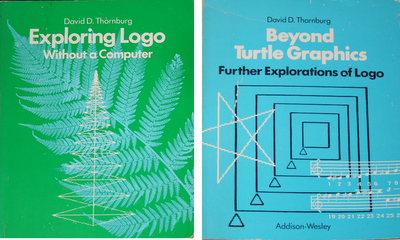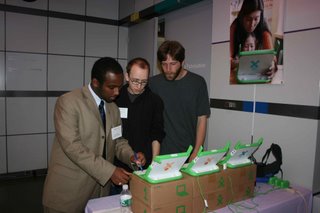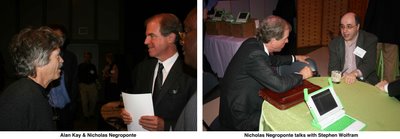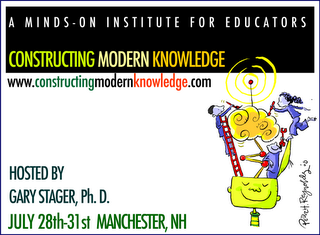Jeff Utecht and
David Warlick are among the latest educators to bemoan the lack of educational technology use by educators. In this case, Warlick and Utecht are specific in their criticism. They ponder aloud why the Web 2.0 tools
they love do not appeal to more colleagues and why they are seldom used in classrooms. Both author/educators desire an education revolution, even if they have yet to articulate what that would look like in practice.
I have attempted to explore the question, "Why don't teachers use computers?" in various publications, notably addressing technical obstacles in
Why Teachers Don't Use Computers; teacher recalcitrance in
Gary Stager on Tech Insurgents; and a lack of leadership in
Laptop Woes: Bungling The World's Easiest Sale.
Utecht expresses his frustration with colleagues who don't share his enthusiasm with Web 2.0 in a blog entitled "
Fear Factor."
"My job, and I believe the job of every educational technology person is to help people get over this fear. To encourage them to explore these amazing machines. This year at my school we’ve loaded some very cool programs onto every teacher computer, and created shortcuts on the desktop so they had easy access to programs such as Skype, Google Earth, Second Life, and Scratch just to name a few. Yet I wonder how many teachers haven’t even clicked on one of these shortcuts to see what happens. Most haven’t even deleted the shortcuts even though they never plan to use them, or don’t know what to do."
The larger questions of why teachers don't continue to learn and grow are impossible to answer for there are so many factors in play. The range of finger pointing in response to Warlick's "
rant" verifies the complexity of the issue. However, I think it is much easier to explain why teachers fail to embrace Skype, Google Earth and Second Life with the zeal of many "Web2.0pians." This requires a historical perspective. I believe it might be useful to compare the current situation to another heyday of educational computing. In this case, the 1980s and the "Logo community."
A bit of history of another "edtech" community
In 1966, Seymour Papert, Wally Feurzig, Cynthia Solomon and others invented Logo as a programming language for children that would allow them to explore powerful ideas by interacting with cybernetic "objects to think with." Papert had helped Jean Piaget learn how children construct mathematical knowledge and then went on to be a pioneer in the field of artificial intelligence. Logo, built upon the AI language, LISP was designed as a "mathland" in which children might learn math as naturally as one would learn French by living in France. Math would be relevant, powerful and beautiful. In the late 60s Papert proposed a computer for every child when that was dismissed as heresy. Papert's work with Logo inspired Alan Kay to invent the dynabook in 1968, the predecessor to the modern laptop and "personal computer" was thought to be a computational learning space for children. The NSF, NIH and even the Pentagon funded seminal Logo research. Psychologists, computer scientists, learning theorists, mathematicians and teachers were collaborators.
By the time microcomputers became available, the MIT AI and Logo labs had published extensive research on children learning with Logo as did researchers around the world. In the early 80s and in the world's first "laptop schools" ten years later, the purpose of computers was to "do" Logo. The language, always designed to allow a wide range of personal expression and intellectual inquiry continued to evolve with advances in computing, but it was
explicitly designed as an environment for children. When David Thornburg taught Logo to Stanford engineering grad students, the work was fantastic, but outside of the primary objectives for the software. HyperCard and HyperStudio were heavily influenced by Logo and the Logo community. Squeak, Scratch, StarLogo, NETLogo, Toontalk, Agentsheets, Stagecast Creator and other software environments are Logo's cousins.
LCSI's LogoWriter invented the site license.

Logo's academic community grew rapidly as countless teachers around the world found Logo on their new classroom computers. The needs and objections of teachers became important subjects for investigation, debate and R&D.
Byte dedicated an entire issue to Logo. One of the longest running educational technology journals,
Logo Exchange, was published for close to twenty years. Dozens of how-to books filled with creative classroom project ideas
and pedagogical strategies were published all over the world. Online conferences, beginning in 1985 supported the Logo community and summer institutes continue to this day. Seymour Papert and children using Logo were featured on
Donahue. The BBC made a documentary about Logo. Logo conferences in the mid-1980s were major academic events attracting scholars and practitioners from around the world. Classroom teachers found themselves in collegial settings with leading intellectuals.
Perhaps, the most important thing to know about Logo was that it came with an
owner's manual in the form of an educational manifesto, entitled
Mindstorms: Children, Computers and Powerful Ideas. This 1981 book by Seymour Papert not only called for an educational revolution, but it predicted how schools would reject and ultimately defeat such efforts. However, the book became a bestseller all over the world and resonated with educators committed to progressive education. Not only did Papert offer Logo as a way of breathing life into Dewey, Piaget, Holt and Vygotsky, but Logo also energized a community of educators eager for social justice. Papert was a South African dissident who fought apartheid in the late 40s and early 1950s. Many of my colleagues in the Logo community fought for civil rights and against the war in Vietnam. To them, Logo was not just a programming language or an educational philosophy, it was also a way of empowering young people to use their minds in an independent fashion.
Logo was a way of giving voice to their democratic principles and amplified their child-centered teaching practices.
Logo was explicit in stating that the best learning was comprised of "hard-fun." Although Logo has no threshold and no ceiling, it does require a great deal of debugging and mastery in order to get the computer to behave in the way you want. This is the power of programming. It provides agency over the machine and enhances the intellectual stature of the learner.
As more computers were delivered to schools and the enthusiasm of the early adopters were drowned out by teachers with other priorities, Logo became harder to sustain in schools. Add commercial pressures that devalued children making their own software (for obvious reasons) and the rest is history (except I just got back from a Logo conference in Eastern Europe).
Web 2.0 today
Now, how does this compare with the concerns raised by Utecht, Warlick and their colleagues in the Web 2.0 community?
Like 25 years ago with Logo, some creative teachers today have become smitten with Web 2.0 technologies. They do creative things with the tools themselves and engage kids in interesting projects. They too can't understand why colleagues do not share their enthusiasm. These early adopters are great evangelists for the technology and hope that their work will result in school reform.
However, there are some primary differences between Logo (and its variants) and the panoply of Web 2.0 tools, including:
- The Web 2.0 tools promoted by Warlick and Utecht were not created by educators or for children. Educators hope to find educational applications despite having almost no input into the development of future tools.
- The Web 2.0 tools come out of corporate, not academic, cultures with very different motives.
- There is no educational philosophy inspiring the development of the Web 2.0 tools or their use.
- Although a principle of the Web is the democratiziation of knowledge, this is an abstract concept to educators raised on textbooks and being commanded to recite from scripted lesson plans.
- The greater Web 2.0 community has little interest in reforming education.
- Web 2.0 attracts very little interest in the educational psychology or even teacher education communities.
- There exists very little peer-reviewed scholarship regarding Web 2.0. In fact, many people in the blogosphere are openly contemptuous of theory and scholarship in favor of "the wisdom of crowds," a new and popular, albeit inherently anti-intellectual world-view.
- By definition, the Web 2.0 community is leaderless. Too often, non-equivalent opinions are given equal weight without a demand for evidence or supporting arguments.
- There is very little material written for educators on using Web 2.0 tools in a creative fashion. Will Richardson's book is a fabulous resource for understanding the read/write web, but hardly offers provocative project ideas.
- No matter how cool, powerful or revolutionary Web 2.0 tools happen to be, there are few if any mature objects-to-think-with embedded in them and certainly no explicit statement that their use is designed to transform the learning environment.
- The emphasis on information reinforces passive pedagogical practices, whether intentional or not.
- While they may be really powerful or innovative software applications, a teacher simply does not need Skpe, Google Eartth or Second Life. Using them will do little to challenge conventional classroom practice. Some of the richest examples merely enhance the existing curriculum.
- Web 2,0 requires robust ubiquitous access to the Internet. Most schools have demonstrated an inability to trust teachers and kids online and as a result create insane barriers to teachers using the Web in an educational fashion.
- By definition, Web 2.0 is temporal (just wait for 3.0) and new tools emerge every hour. As a result, teachers don't see a reason to invest much time in mastering technologies that will be obsolete or leapfrogged tomorrow. For many enthusiasts, collecting the tools is as important as using them.
- Times have changed. Few Americans protest anything, not the war in Iraq, not the erosion of civil liberties. Educators don't even fight overly restrictive and counter-productive network policies that castrate the Internet. Has ISTE raised the issue before Congress? Has the NEA made this an issue of working conditions? No, there is little appetite for rocking the boat. We have become passive and compliant just like our schools wish for our students.
- I know I'll get flamed for this, but the educational Web 2.0 community has little first-hand experience in social activism and scant knowledge of existing school reform literature. Like the discovery of new tools, one gets the sense that proponents of Web 2.0 in education are discovering educational theories here and there and then applying these ideas to the new tools.
- What is the unifying educational theory behind using Skype, Second Life, Scratch and Google Earth?
When Nobel Peace Prize Winner,
Oscar Arias campaigned for President of Costa Rica, he promised to modernize the nation's public schools. Once elected he did not neglect his pledge or buy a white board for each classroom. Instead he asked Seymour Papert and his colleagues to help Costa Rican educators use Logo as a vehicle for empowering children and teachers. The primarily low-skilled and female teaching force across Costa Rica took this mission seriously as a way of not only asserting their competence, but to improve the quality of life in their country. The NGO Arias created, Fundacion Omar Dengo, to support classroom innovation and Logo use has withstood countless changes in government and succeeds to this day. More than a million Costa Rican school children use MicroMundos (MicroWorlds) and Intel selected Costa Rica as the home of its chip manufacturing plant over ten other countries. They cited the educational system and the "Computers in schools" project as a primary reason for their investment. That investment represents something like 25% of the GDP of the nation.
Dr. Geraldine Kozberg was an interesting figure in the development of Logo use in American schools. She was Assistant Superintendent of the St. Paul, Minnesota schools and an educator who came to the profession late in life. Prior to St. Paul, Dr. Kozberg volunteered to work in the South Boston High School during the "
busing" crisis of the early 1970s when White parents shot at school buses to keep their schools from being integrated. As she headed towards retirement, Dr. Kozberg spent her vacations working to establish schools in refugee camps on the Thai/Cambodian border. She was not a technologist at all. She was however a radical and progressive educator in the best sense of both words who after reading Papert's book,
Mindstorms: Children, Computers and Powerful Ideas, called Papert and said, "I don't believe you. Come to St. Paul and prove it to me." The St. Paul Logo project lasted for more than a decade and served as a model of longterm, serious and sustainable professional development for educators. In St. Paul, Logo was not a technology initiative, but rather a catalyst for classroom change. This was not a secret, but its stated mission. The district invested human and financial resources accordingly.
What is the radical educational foundation of Skype? Besides, kids don't need to master Skype or even have it available in school. They can use it and other Web 2.0 tools outside of school with very little instruction and almost no practice or fluency required.
Kozberg wrote a reflective piece that might be useful in considering the current situation facing the Web 2.0 community,
Whatever Happened to the Revolution? Seymour Papert's article,
Why School Reform is Impossible, may also shed some light on the subject.
I remember a conference I chaired in New Jersey around 1990 or 1991. Gerry Kozberg spoke and afterwards a well-intentioned suburban computer coordinator came up to her and said that she too was a radical. Dr. Kozberg took her hand and said, "Darling, you're a nice woman, but you're no radical."
In 1996, Kozberg told the audience at Logosium '96 the following:
"The Logo community has been unable or unwilling to confront the larger social issues that are tearing at public education. In 1981, I wrote: "Logo is one part of a larger change effort designed to serve as an intervention in learning and learning environments.""
For the most part, this has not happened. The problem is not the technology, certainly not Logo. The problem is one of equity. Logo is for all kids, but the kids who need Logo the most have no access to it. They are relegated to educational games and instruction in the basic skills.
In the world of Web 2.0, being leaderless is a virtue and the value of expertise is democratized, if not minimized. There is no educational theory on which the tools are designed or the classroom practice is influenced. No critically acclaimed or even popular manifesto exists. It is difficult to sustain a "revolution" when its goals remain unclear and the soldiers rally around the tools, not ideals.
Labels: David Thornburg, david warlick, Jeff Utecht, logo, Seymour Papert, web 2.0




